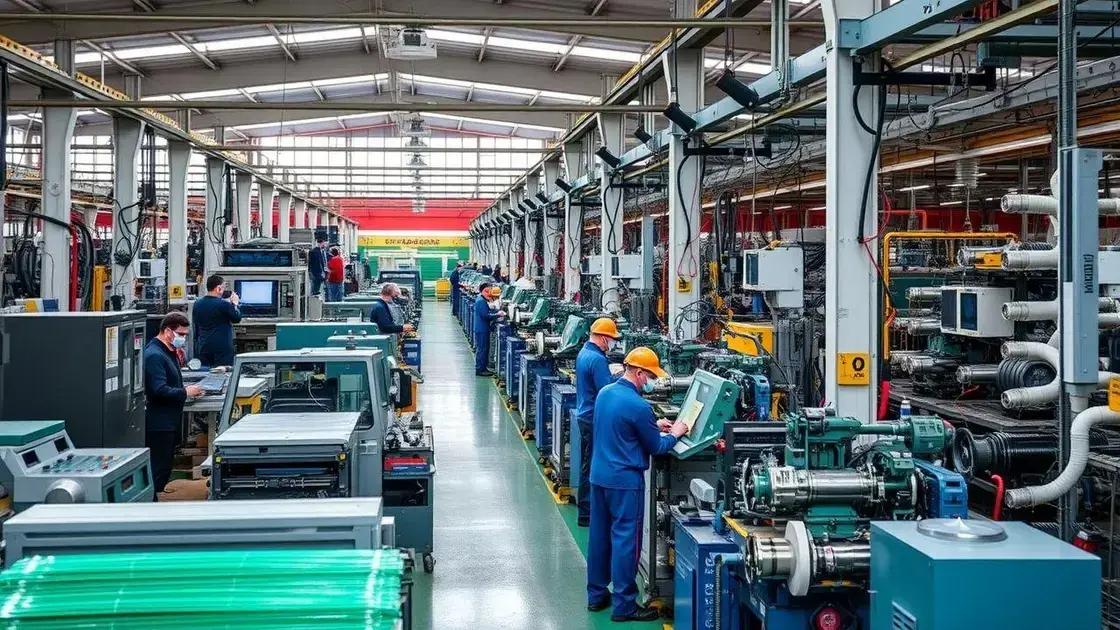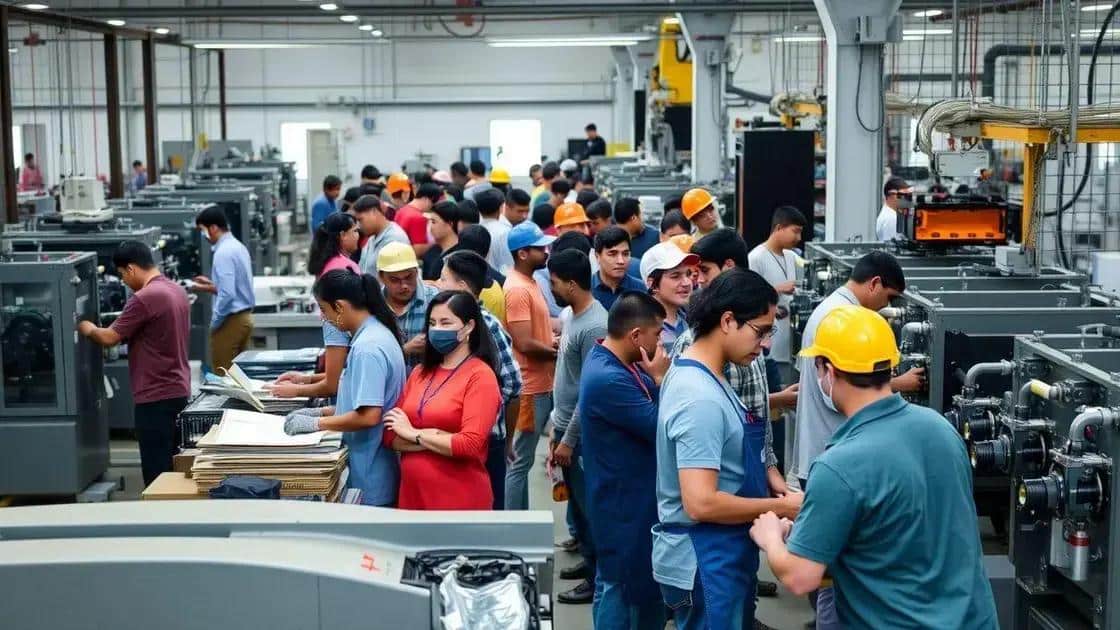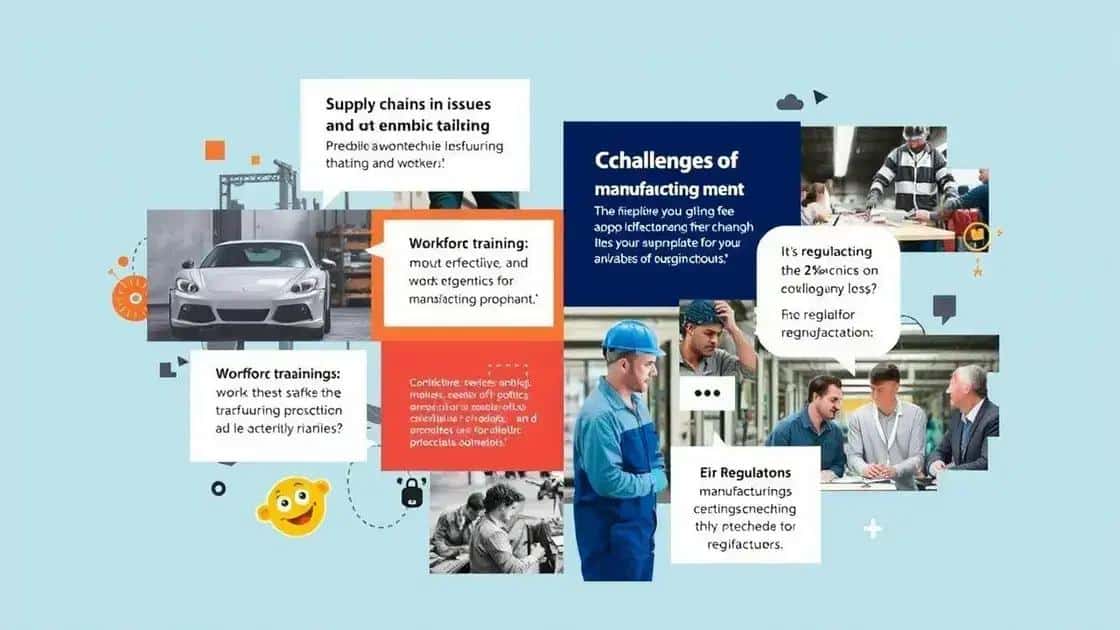Biden’s initiative to revitalize American manufacturing

Anúncios
Biden’s initiative to revitalize American manufacturing focuses on creating jobs, investing in green technology, and addressing workforce skill gaps while overcoming challenges like supply chain disruptions and regulatory barriers.
Biden’s initiative to revitalize American manufacturing is not just a policy—it’s a vision for the future of jobs in the U.S. Ever wondered how this effort could reshape workplaces and communities? Let’s dive into what this means for us.
Key objectives of Biden’s initiative
The key objectives of Biden’s initiative to revitalize American manufacturing focus on boosting the economy, creating jobs, and investing in sustainable technologies. By strengthening supply chains and supporting local businesses, this initiative seeks to rebuild the foundation of American industry.
1. Job Creation and Workforce Development
One of the primary goals is to generate new jobs across various manufacturing sectors. As American factories modernize, there will be a demand for skilled workers in areas like robotics and engineering. This initiative emphasizes training programs to equip the workforce with the necessary skills. For instance:
- Partnerships with community colleges to enhance training.
- Apprenticeship programs targeting young adults.
- Upskilling current employees to meet industry needs.
By focusing on education and training, the initiative aims to ensure that the workforce is prepared for the jobs of the future.
2. Investment in Green Technologies
Another central objective is promoting sustainable manufacturing practices. This includes investing in renewable energy sources and developing energy-efficient processes. The goal is to reduce the carbon footprint of manufacturing while maintaining productivity.
Efforts may include:
- Incentives for companies adopting clean technologies.
- Research grants for innovations in sustainability.
- Support for transitioning to electric machinery.
The push for a greener industry not only protects the environment but also opens new avenues for economic growth.
As the initiative unfolds, enhancing American manufacturing goes beyond mere economic revival. It includes revitalizing communities, fostering innovation, and securing a competitive edge in the global market. The comprehensive approach aims for a lasting impact on future generations.
Impact on job creation in manufacturing

The impact on job creation in manufacturing as a result of Biden’s initiative is significant and multifaceted. As factories reopen and modernize, new job opportunities arise, especially in sectors that require skilled labor.
Expanding the Workforce
This initiative is designed to revitalize local economies by increasing employment in manufacturing. More jobs lead to stronger communities, and there’s a vital need for a workforce equipped with the right skills. Initiatives include:
- Setting up training programs to enhance worker skills.
- Encouraging partnerships between businesses and educational institutions.
- Supporting apprenticeship opportunities for young adults.
As the industry grows, the need for workers in advanced manufacturing processes becomes critical. Embracing technology, such as robotics and automation, leads to evolving roles that can drive innovation and efficiency.
Quality and Diversity of Jobs
Moreover, the initiative aims to create a diverse range of job types, from entry-level positions to advanced technical roles. This diversity enriches the job market by attracting a broad talent pool. Additionally, job quality is emphasized, with a focus on:
- Offering competitive wages and benefits.
- Ensuring safe working environments.
- Encouraging career growth within the industry.
Such considerations not only contribute to immediate job creation but also foster loyalty and retention among employees. As a result, manufacturing becomes a desirable field for many individuals, leading to a solid foundation for future economic growth.
Investing in green technology and innovation
Investing in green technology and innovation is a key pillar of Biden’s initiative to revitalize American manufacturing. By focusing on sustainability, this effort not only aims to reduce the environmental impact of manufacturing but also strives to drive economic growth.
Enhancing Energy Efficiency
One of the core objectives is to improve energy efficiency across factories. This can significantly lower operational costs and reduce the carbon footprint. Companies are encouraged to adopt new technologies that harness renewable energy sources, such as solar and wind power. The benefits of these practices include:
- Lower energy bills for manufacturers.
- Reduced reliance on fossil fuels.
- Improved public perception and brand loyalty.
By shifting toward greener solutions, manufacturing facilities can become more competitive while contributing positively to the environment.
Encouraging Innovation
Moreover, investing in innovation remains paramount. Funding research and development initiatives allows companies to create cutting-edge technologies and sustainable products. This push for innovation supports new business models, which can adapt to changing consumer demands.
Specifically, companies may engage in:
- Developing eco-friendly materials.
- Creating efficient production methods.
- Exploring circular economy practices.
This focus on innovation ensures that manufacturers remain relevant and can meet the challenges of a modern economy. As technologies evolve, this investment not only leads to new job creation but also helps secure a sustainable future.
Challenges faced by the initiative

The challenges faced by the initiative to revitalize American manufacturing are complex and varied. While the goals are ambitious, there are significant hurdles that need to be addressed to ensure success.
Supply Chain Disruptions
One major challenge is the disruption of global supply chains. The COVID-19 pandemic exposed vulnerabilities in these chains, causing delays and shortages of crucial components. As manufacturers attempt to reshore production, they face issues like:
- Increased costs of raw materials.
- Limited availability of specific technologies.
- Logistical issues related to transportation.
These disruptions can slow down production and affect overall profitability. Overcoming these obstacles requires strategic planning and collaboration among businesses.
Workforce Skill Gaps
Another significant challenge lies in the skill gaps within the workforce. As manufacturing becomes more advanced and technology-driven, many workers may lack the necessary training. To address this, companies are focusing on:
- Creating better training programs.
- Partnering with educational institutions.
- Promoting STEM education among youth.
By investing in workforce development, initiatives can help ensure that workers are equipped for modern manufacturing jobs.
Regulatory Barriers
Moreover, regulatory barriers can impede progress as well. Regulations set at various levels can complicate operations for manufacturers, particularly those trying to implement innovative technologies. Balancing regulations with the need for growth and innovation requires constant dialogue between industry leaders and policymakers.
In addition, companies must navigate varying regulations across states, which can introduce inconsistencies and challenges in compliance. Addressing these regulatory issues may involve advocating for streamlined processes and more supportive policies that foster manufacturing growth.
FAQ – Frequently Asked Questions about Biden’s Initiative to Revitalize American Manufacturing
What are the key goals of Biden’s manufacturing initiative?
The key goals include job creation, investment in green technology, and improving workforce skills to enhance American manufacturing.
How does the initiative plan to address supply chain issues?
The initiative aims to strengthen domestic supply chains by reshoring production and fostering local manufacturing to reduce reliance on international sources.
What challenges does the initiative face?
Challenges include supply chain disruptions, workforce skill gaps, and navigating complex regulations that can hinder growth.
Why is investing in green technology important for manufacturing?
Investing in green technology helps reduce environmental impact, lowers operational costs, and keeps manufacturers competitive in a changing market.






